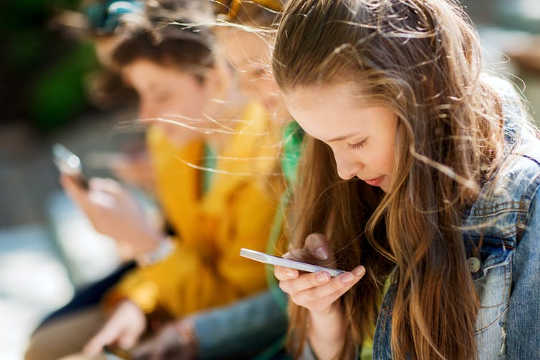 www.shutterstock.com
www.shutterstock.com
For tweens and early teens, the rise in time spent on Snapchat, WhatsApp, Instagram and other social media is really quite dramatic. Culture minister Matt Hancock recently suggested the government could impose limits on the amount of time children spend on social media. In February, the House of Commons Science and Technology Select Committee launched a new inquiry to examine the health risks to children and young teens of increasing amounts of time on social media.
Our new study set out to look at patterns of behaviour among ten to 15 year olds in the UK, and their levels of well-being, to see if all this time spent online was having a detrimental impact on their mental health. We found that teenage girls are by far the highest users of social media, and those who are using it for more than an hour a day are also at the highest risk of developing well-being problems in later teen years.
We used the youth participants’ data from the UK household longitudinal study, Understanding Society, following almost 10,000 young people from diverse backgrounds across the whole country between 2009 and 2015.
We asked the young people to report on how much time they spent on social media on a “normal school day”. A few reported no internet access or no time spent at all, but some were on it for four hours or more. We found that 10% of ten-year-old girls reported spending one to three hours a day (compared with 7% of boys) and this increased to 43% of girls at age 15 (and 31% of boys).
We assessed two measures of well-being for these young people. The first was a combined score of their answers to questions about satisfaction with schoolwork, friends, family, appearance, school and life as a whole. The second measure was a well-established questionnaire which asked the young people about their social and emotional difficulties.
At age ten, girls who interacted on social media for an hour or more on a school day had worse levels of well-being compared to girls who had lower levels of social media interaction. Additionally, these girls with higher social media interaction at aged ten were more likely to experience more social and emotional difficulties as they got older. While our study was unable to say that the higher level of social media use among young girls directly caused the mental health issues, there was a strong association.
For both boys and girls, levels of happiness decreased between the ages of ten and 15, however the decrease among girls was greater than that of boys.
What makes girls different?
There are number of possible reasons why girls are more affected by social media use than boys. Girls participate in more comparisons of their own lives with those of the people they are friends with or follow. Viewing filtered or photoshopped images and mostly positive posts may lead to feelings of inadequacy and poorer well-being. Girls also feel more pressure to develop and maintain a social media presence than boys. Social media presence requires constant updating and having friends share or like their content. If their perceived popularity decreases over time, there may also be an increase in social and emotional difficulties.
Boys, on the other hand, are much more likely to participate in gaming online and via consoles than they are social media, and that wasn’t covered by our study. Boys’ levels of well-being may be more related to gaming.
So what can be done to help protect young people from the potential damage to their mental health? Social media interaction does not appear to be a short-lived phenomenon. A recent report by the Children’s Commissioner for England, Life in Likes, suggested imploring social media platforms to check underage use and preparing children better for life in a digital age. The recommendations did not discuss potential gender differences; but the findings from our study suggest that boys and girls can have varying responses to high levels of social media interaction.
There have also been calls for the technology industry to look at in-built time limits. Our study really backs this up – the amount of increasing time online is strongly associated with a decline in well-being among the young, especially for girls. Of course, young people need access to the internet for homework, for watching TV and to keep in touch with their mates. But they probably don’t need to spend two, three or four hours chatting, sharing and comparing on social media every school day.![]()
About The Author
Cara Booker, Research Fellow and Deputy Director of Graduate Studies, Institute for Social and Economic Research, University of Essex
This article is republished from The Conversation under a Creative Commons license. Read the original article.
Related Books
at InnerSelf Market and Amazon

























